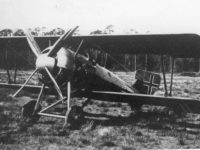The Siemens Schuckert D.III emerged from the various prototypes of the D.II, which were only built and developed to test the new Siemens & Halske Sh.III circulating motor. Only after the first deficiencies were corrected could the D.III prove itself as a good interceptor.
Development and construction:
After the start of production at Siemens-Schuckert D.I, engineer Harald Wolff was already working on a prototype that was able to accommodate the new Siemens & Halske Sh.III rotary engine. A total of six aircraft were built and extensively tested. The last version, the D.IIe seemed to be so promising that it was presented in October 1917 as D.III of the German army leadership.
On December 26, 1917 initially only 20 aircraft were ordered, which were used in January 1918 on the Western Front. In February, the next order of 30 aircraft followed.
Use in the First World War:
The Jagdgeschwader 2 was the first to receive the new aircraft. Already after the first missions, the pilots reported that the engine tends to overheat quickly and also threatened piston eats and crankshaft breaks. Siemens-Schuckertwerke had some of the aircraft already built cut out part of the bonnet in order to be able to cool the engine better. Also some other deficiencies were fixed, so that the airplanes could be used starting from July 1918 again at the front.
After fixing the deficiencies of the engine, the very good climbing performance of the aircraft showed up, so that they were mainly used as interceptors until the end of the war.
Technical specifications:
| Designation: | Siemens-Schuckert D.III |
| Country: | German Empire |
| Typ: | Fighter plane / Interceptor |
| Length: | 5,75 meters |
| Span: | 8,43 meters |
| Height: | 2,8 meters |
| Mass: | 523kg empty |
| Crew: | Max. 1 |
| Engine: | Siemens & Halske Sh.III eleven-cylinder rotary engine 210 hp |
| Maximum speed: | 190 km/h |
| Reach: | 360 kilometers |
| Armament: | 2 x synchronized machine guns 7,92 mm LMG 08/15 |
You can find the right literature here:
Fokker Dr I Aces of World War 1 (Aircraft of the Aces)
Undoubtedly the most famous fighter type to see service on either side during World War 1, the Fokker Dr I was a revelation when it entered service on the western front in 1917. Manfred von Richthofens JG 1 circus was the first Jasta to completely re-equip with the new fighter, and in the skilled hands of its numerous aces the Dr I proved a formidable opponent. The Dr I remained in service on the Western Front until replaced by the superior Fokker D VII in May 1918. Just weeks prior to that, however, Germanys leading ace, the great Red Baron, had been killed at the controls of a Dr I.
Friedrichshafen Aircraft of WWI: A Centennial Perspective on Great War Airplanes (Great War Aviation) (Volume 21)

Friedrichshafen Aircraft of WWI: A Centennial Perspective on Great War Airplanes (Great War Aviation) (Volume 21) Paperback – February 16, 2016
This book describes and illustrates the development of Friedrichshafen aircraft of WWI with text, 540 photos, 18 in color, 37 color profiles, production quantities and serial numbers of aircraft, and aircraft dimensions and performance specifications. In addition, there are 26 official SVK drawings and 11 aircraft are illustrated in scale drawings to 1/48 (4) or 1/72 (7) scales. The book has 312 pages and is of interest to aviation historians, enthusiasts, and modelers alike.
German and Austro-Hungarian Aircraft Manufacturers 1908-1918
Much has been written about the British aircraft of the First World War, but little has surfaced about the aircraft of the Axis powers, Germany and Austria. Here, Terry C. Treadwell tells the story of the aircraft from companies such as Fokker, builder of the famous triplane, as fl own by Baron von Richthofen's Flying Circus, AEG, Albatros, Junkers and Hansa. From reconnaissance aircraft to state-of-the-art bombers that could reach London, this is the definitive guide to aircraft of the Axis powers during the First World War. The aircraft are explained in detail and a history of each company is provided, making this an excellent source book for aircraft enthusiasts, model makers and those interested in the air war over the trenches of France and Belgium, as well as further afield in the Italian campaign.
The Zeppelin in Combat: A History of the German Naval Airship Division
The standard reference now revised and expanded. Dr. Robinson has opened up his vast photo archives to enhance this new edition of his classic work. Much of the new photographic material is published here for the first time.
This post is also available in:
 Deutsch (German)
Deutsch (German)  Français (French)
Français (French)  Italiano (Italian)
Italiano (Italian)  简体中文 (Chinese (Simplified))
简体中文 (Chinese (Simplified))  Русский (Russian)
Русский (Russian)  Español (Spanish)
Español (Spanish)  العربية (Arabic)
العربية (Arabic)















